Radishes are massively underrated veggies. Their spice levels are just as variable as peppers and chillies, and the colour and crunch they add to salads are outstanding. This guide selects some of the best, brightest, largest, and most disease-resistant types of radishes to grow in Australia, and every single one is worth growing.
More...
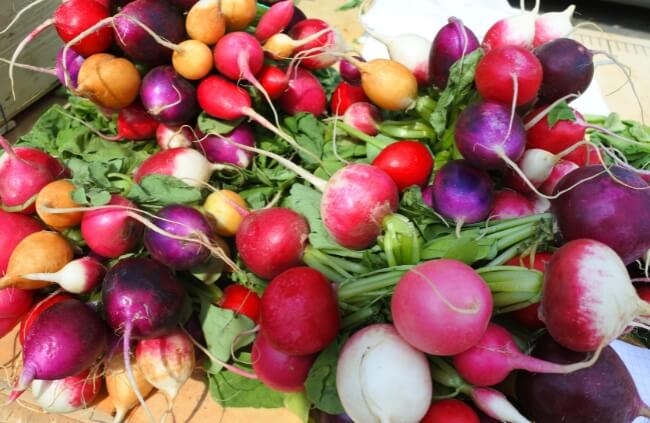
Family: | Brassicaceae |
|---|---|
Genus: | Raphanus |
Species: | R. sativus |
Common names: | Radish |
Origin: | Southeast Asia |
Location: | Outdoor |
Type: | Edible root vegetable |
Growth: | Depends on variety |
Sun requirements: | Full sun or light shade |
Foliage colour: | Green |
Flower colour: | White, pink, purple, blue or yellow |
Flowering: | Summer (year-round in cultivation) |
Edible parts: | All parts are edible |
Maintenance level: | Low |
Poisonous for pets: | Non-toxic to pets |
What are Radishes?
Radishes are the harvested root of Raphanus sativus, a leafy green vegetable in the Brassicaceae family (cabbages, mustard, broccoli, etc.). It is their roots, not their greens though that are the real prize.
They are also one of the fastest cropping veggies you can grow at home, developing edible roots in as little as four weeks, with the added bonus of being a year-round crop in pretty much every part of Australia.
Identifying Radishes
There is a slight difference between radishes and daikon, and some of the varieties in the section below are particularly similar to turnips in terms of colouring and root form, but there’s no mistaking a radish once you bite into it.
Daikon will grow in the same conditions as radishes, but they are native to Japan specifically, and while some of the radish varieties in the list below are hybrids between Raphanus sativus var. longipinnatus (Daikon) and Raphanus sativus, they are definitely, distinctly, radishes, with crisp, refreshing flesh and a clean spicy bite.
24 Types of Radish to Grow in Australia
1. Radish ‘Black Spanish’
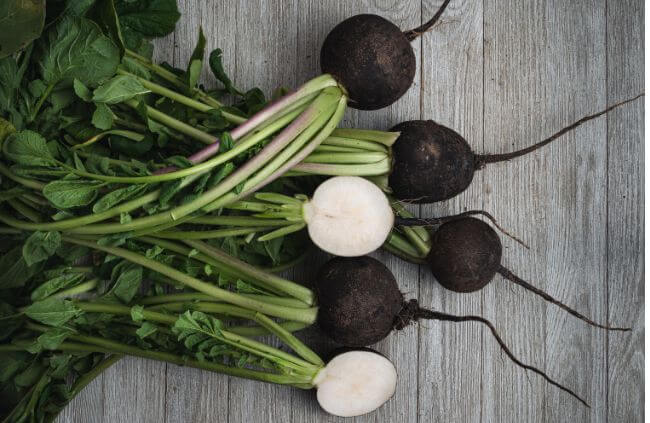
‘Black Spanish’ is one of the best radishes you can grow in Australia. Its thick flesh protects the root from splitting, and its strong flavour, paired with its size (each root can be nearly 7 cm across) makes it ideal for grating, rather than slicing into coleslaws and other mixed salads.
‘Black Spanish’ radishes can be sown and grown all year round, but prefer milder springs and autumns in Australia.
2. Radish ‘Cherry Belle’
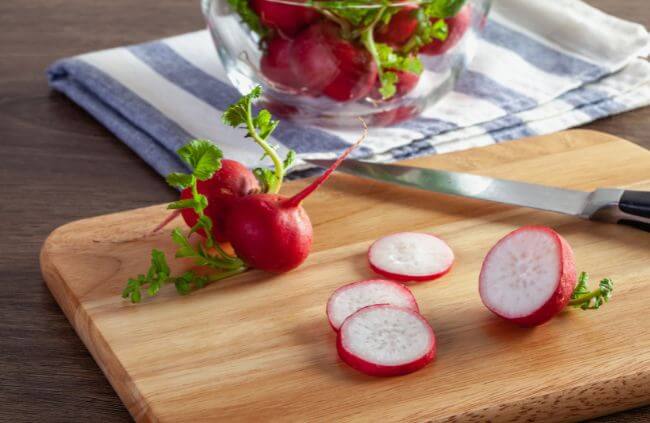
‘Cherry Belle’ is a beautiful radish, and particularly easy to grow. Its small roots don’t need much feeding, and can cope with minimal watering, with crops in as little as 5 weeks.
The roots are bright red from top to tail but have a wonderfully succulent white flesh, and their dwarf leaves are perfect for salads or tossed in a pan to wilt down with sliced garlic.
3. Radish ‘Crimson Giant’
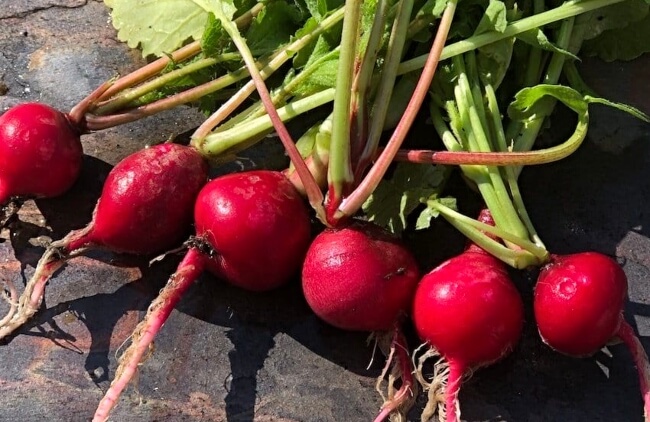
Source: San Diego Seed Company
‘Crimson Giant’ is big for a radish, but it's not the biggest root in this list. The roots are the size of a golf ball, and their tough skin makes them less susceptible to splitting and rotting in the ground.
Fresh green foliage is easy to achieve too as a bonus crop when you harvest them, and has a much smoother texture than most radish foliage. The roots develop a long tail, so tend to have a slightly pointed tip to their vivid red roots.
4. Radish ‘Daebu Summer’
Also called ‘Mino Summer’ or ‘Minowase Summer Cross’, these long white radishes are a daikon hybrid and are great for summer growers, with excellent bolt resistance. The white flesh and white skin are an indication of mild flavour, but they have a uniqueness that isn’t quite daikon and isn’t quite radish.
‘Daebu Summer’ is a great option for summer growers looking for something a little fresher for salads.


Get Your Free Guide:
Master Growing Australian Natives eBook
A Must Have Complete Guide for Every Australian Garden
Get Your Free Guide:
Master Growing Australian Natives eBook
A Must Have Complete Guide for Every Australian Garden
5. Radish ‘Early Scarlet Gold’
‘Early Scarlet Gold’ is one of my favourite radishes for Australian gardens. It was developed for European growers, but works perfectly as a winter radish in Australia, no matter where you are.
These small radishes are perfectly formed, with thin, smooth red skins, and while they do split with irregular watering, they are worth the stress. They’ve got a wonderful kick, and if you leave them in the ground, are quick to go to seed, offering intensely spicy seeds for a bonus harvest off of any split roots.
6. Radish ‘Easter Egg’
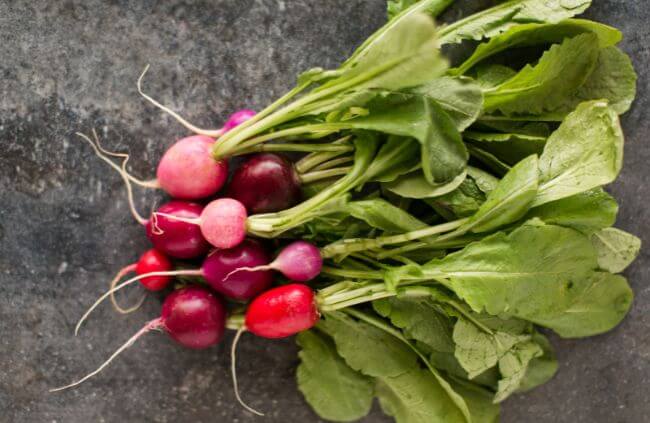
‘Easter Egg’ radishes aren’t strictly a radish variety. It’s a grouping of coloured varieties (‘Cherry Belle’, ‘Purple Plum’, ‘White Beauty’ and ‘Pink Beauty’) that produce a beautiful arrangement of salad radishes in all different colours.
They are selected as a mixed crop because they share the same needs and crop at the same time, meaning you can pull a selection of these roots for the table and have a rainbow salad with ease.
7. Radish ‘Fire and Ice’
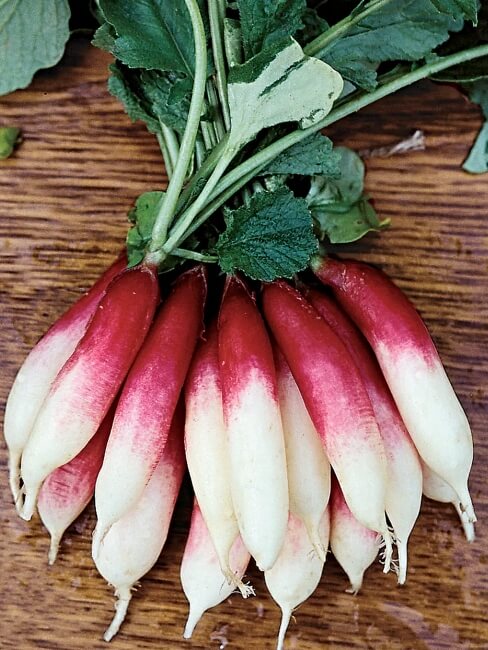
Source: Burpee Seeds
‘Fire and Ice’ is a great radish for growing in pots, or loosely cultivated raised beds. They need well-drained soil with stones, twigs, and large clumps of compost removed.
Preparing the bed isn’t just about getting the right shape on these stunning, long-rooted radishes, it prevents disease too, as they need to grow straight down to avoid kinks that can open up and split the skins.
8. Radish ‘French Breakfast’

‘French Breakfast’ Radishes are undeniably the most popular radishes on the planet. They are the first that come to mind when asked to advise a reliable crop, and the first radish you picture when you’re planning your dinner.
They might not be exciting, but they’re reliable, crop well, and with the right management can be grown all year round in every part of the country.
Check out our full guide on growing French breakfast radish or watch Nathan's detailed YouTube video for step-by-step instructions:
9. Radish ‘French Dressing’
Like ‘French Breakfast’, ‘French Dressing’ radishes are thin, elongated, and have a dainty white tip at the base of their root. However, they are about half the size of ‘French Breakfast’ radishes and a perfect little mouthful.
Sliced in half down the length, they add structure, crunch and interest to salads, with minimal preparation.
10. Radish ‘Fuego’
‘Fuego’ Radishes are one of the best disease-resistant radishes you can grow, and exceptionally resilient in hot dry weather too. Their deep, blood-red skins make them look more like beetroot than radish, but inside is a spicy, white-fleshed treat as good as any of the more familiar varieties, and well worth seeking out.
11. Radish ‘German Giant’

Source: Living Seeds
‘German Giant’ radishes typically get to about 7 cm across but can reach 10 cm in diameter in ideal conditions. If you're growing radishes for shows or local competitions, this is the perfect choice as it will reliably outcompete other varieties in any season.
The roots can develop a nobbly shape if your soil isn’t perfectly even, but regardless of how you grow them, you’ll be rewarded by a delicately spiced root that stores well in the fridge.
12. Radish ‘Giant of Sicily’
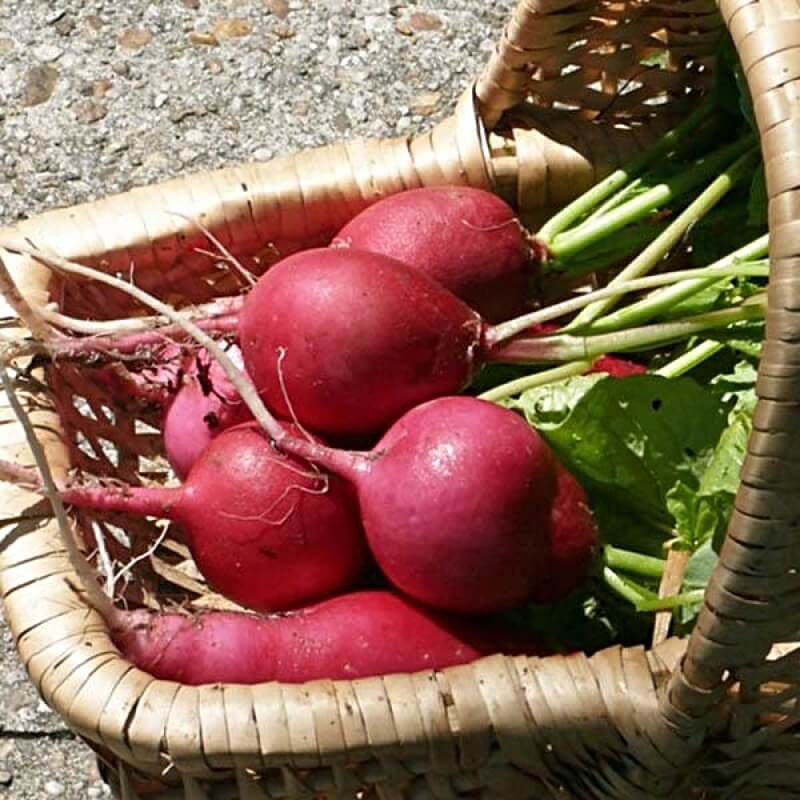
Source: Australian Seed
‘Giant of Sicily’ is another great radish for show growers, though it doesn’t get nearly as big as ‘German Giant’. The real beauty of Giant of Sicily radishes is their colouring. They have deeply saturated scarlet red skin, and when picked young they have a gorgeous white fade at the base of the root.
As they develop the white root fades out and you’re left with a perfectly coloured radish packed with all the flavour of ‘French Breakfast’.
13. Radish ‘Ilka’
Winter and early spring radish crops can be tricky to get right in cooler parts of the country. That’s where early varieties like ‘Ilka’ come in. ‘Ilka’ is a medium-early radish, which crops through the colder months and doesn’t mind slightly less sunshine than others.
It will bolt if grown through summer, so treat ‘Ilka’ radishes as an early crop, and pick another bolt-resistant variety for trouble-free summer growing.
14. Radish ‘Malaga Violet’
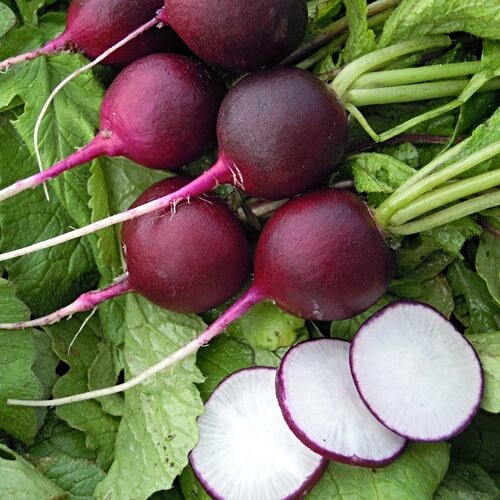
Source: Plant World Seeds
‘Malaga Violet’ is probably the radish with the most character in this list. Its thick purple skin is matched by a sunburst of purple flesh from the centre of the radish, fading out into crisp white flesh. They are utterly stunning when sliced thinly and tossed through salads, and their flavour is delicately balanced between fresh and zesty and richly spiced.
I adore these radishes, and they definitely deserve a space on everyone’s plot, because you’ll never find them in a grocery store, and they’re unique in looks and flavour.
15. Radish ‘Mars’
‘Mars’ is the most commonly grown radish in commercial cultivation in Australia, with a particular value to New South Wales growers. It’s happy in shifting climates, and has great bolt resistance, meaning it can be grown all year round.
They have an even red skin, with a simple white flesh, and are ready to harvest in just five weeks. Their real benefit though is that they can store in the ground for a week or two after they’re ready to pick in mild weather.
16. Radish ‘Mirabeau’
‘Mirabeau’ is a great radish for cooler parts of Australia or for winter growing. It develops small red and white roots, with slight elongation, with each root growing to about 3 cm long and 1 cm in diameter.
If you want a picture-perfect radish quickly, ‘Mirabeau’ is one of the best French radishes there is.
17. Radish ‘Perfecto’
‘Perfecto’ is a breeder’s dream. Not only is Perfecto a good-looking radish, but it's genuinely easy to grow. They have, literally, perfect, blemish-free skin in nearly all conditions, rarely split, and it takes quite extreme conditions for them to bolt.
They are a Mediterranean radish, making them great for well-drained Aussie soils, and resilient against dry summers. But don’t let that trick you into thinking they don’t want any care. Regular feeding and watering ensures an Instagram-worthy radish from Perfecto.
18. Radish ‘Plum Purple’
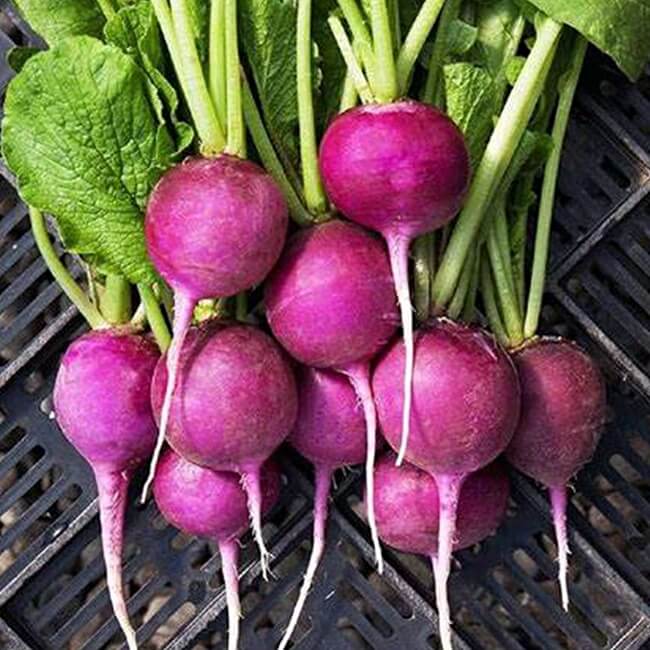
Source: D&H Seed Harvest Co
‘Plum Purple’ is a little easier to grow than ‘Malaga Violet’, with equally stunning purple skins, but you won’t get that same vibrant faded flesh inside once you slice them.
One particular benefit of Purple Plum is that it stores really well. We’ve managed to keep a bag of these in the fridge for well over a month and they’ve not lost their bite.
19. Radish ‘Royal Purple’
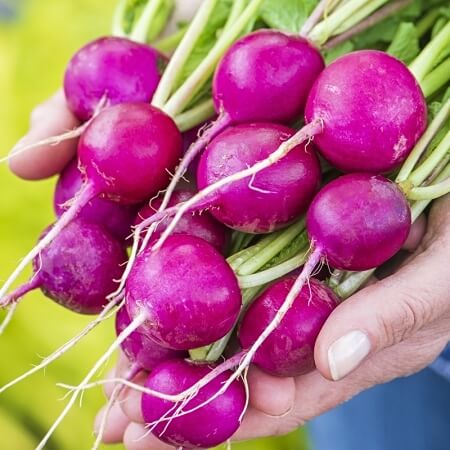
Source: Plants of Distinction
In spring, summer and autumn, ‘Royal Purple’ will produce radish crops within 5 weeks. They are a great, compact radish variety that can be sown quite tightly too, so they are ideal for tight spaces, growing in pots, and excellent for balconies too.
Their skins are a dark, beetroot red, with a hint of violet, and they look spectacular when sliced into wedges and sprinkled over a leafy salad.
20. Radish ‘Scarlet Globe’

Radish ‘Scarlet Globe’ doesn’t offer any bolt resistance in Australia, and it is generally quite attractive to caterpillars and slugs, as we’ve found out the hard way. However, as an autumn crop, it works well and can crop in around 6-7 weeks when sown at the start of winter.
This popular variety is a beautiful radish, despite its lack of resilience, and they tend to grow to a distinctly even size making them great for bunching, whether that’s just for your own satisfaction or if you’re entering horticultural shows.
21. Radish ‘Sichuan Red Beauty’
‘Sichuan Red Beauty’ is one of the deepest-coloured radishes you can grow, but it’s definitely one for cooler parts of Australia, or autumn/winter growing in warmer parts of the country.
Its red skin, and slightly elongated roots, are matched by a deep red flesh that is packed with antioxidants and can reach 5 cm long and across.
22. Radish ‘Sora’
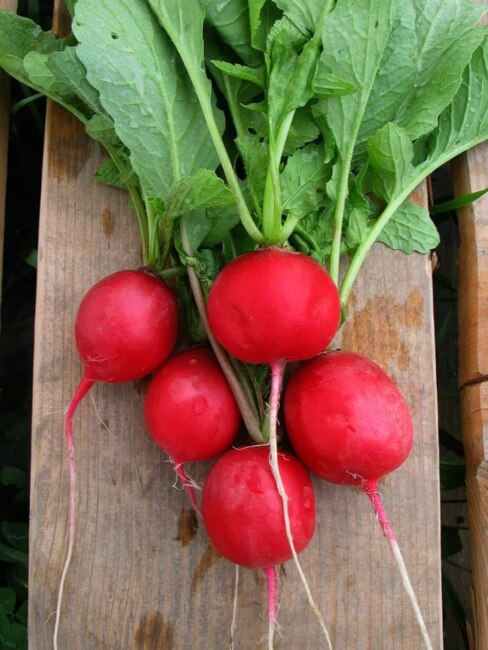
Source: Uprising Seeds
In hotter parts of Australia, ‘Sora’ should be one of your go-to radishes. It’s really well-suited to warm climates and has great bolt resistance. It can be grown all year round, and copes well with winter conditions, but is at its best when cropped quickly in summer.
The root itself isn’t much to write home about, with mild spice, and an even red skin. It’s beautiful, as all radishes are, but ‘Sora’ is all about practical choices for gardeners, rather than culinary excitement.
23. Radish ‘Sparkler’

‘Sparkler’ is a rapid radish. It can grow from seed to harvest in four weeks, and it's packed with moisture. The first thing you’ll notice when you cut into it is the slightly translucent flesh, which is because it just takes whatever moisture is available from the soil, and develops quickly into a 3 cm root.
It’s adored for its mild flavour, and crisp, moist structure, but perhaps its most attractive trait is its skin colouration, which has a vivid distinction between red and white across the root.
24. Radish ‘Watermelon’

‘Watermelon’ is a really unusual radish, with green and white skin that looks distinctly like a turnip and a root that can get to the size of a tennis ball. Inside the seemingly dull skin though, lies a vibrant pink flesh, with fades and clouds of white that give it the distinct look of a watermelon.
The mild but earthy flavour is quite unique to ‘Watermelon’ radish, and not replaceable with other varieties, let alone other veggies.
If you want to experiment with something truly different, this hybrid radish is definitely one for the wish list.
Growing Different Types of Radishes
We’ve got an in-depth guide to growing radishes at home that shares everything you need to know, from soil type to watering times, but to get you started, here are the basic rules for growing your radishes and how to get started.
Every radish in the list above needs the same basic care, but some are disease-tolerant or disease-resistant, and a couple are bolt-resistant, meaning they are better able to cope with summer weather.
But as a general rule, they all need well-drained but fertile soil and a sprinkling of lime at the start of the growing season. Once the soil is prepared, they should be sown at a depth of about 0.5-1.5 cm, in drills 10 cm apart. Space seeds 5 cm apart if possible, or thin them out after germination.
They need at least six hours of direct sunlight per day, and in mid-summer, some shade is beneficial to keep the soil cool.
Caring for Your Favourite Radish Varieties
Once they’re growing well, radishes need watering and feeding where possible, but with such a short growing window, feeding shouldn’t be a chore. Just apply a general-purpose liquid fertiliser once a fortnight to keep soil nutrients topped up.
And most importantly, keep sowing. Radishes grow from seed to harvest in as little as four weeks in summer, so make successional rows of radishes, or sow into pots every two weeks to keep your crop coming all summer long.
Pro Tips for Growing Radishes at Home
If you’re growing radishes in hotter parts of Australia, start your growing season in early autumn, and keep sowing all year. But provide shade for mid-summer crops. A screen of horticultural fleece will do the trick to filter out the harshest of the sun’s rays.
For cooler parts of Australia, start sowing in spring, and make your last sowing at the end of autumn. Cooler and wetter winters can lead to root rot, and no one wants mushy radishes.
Harvesting and Storing Radishes
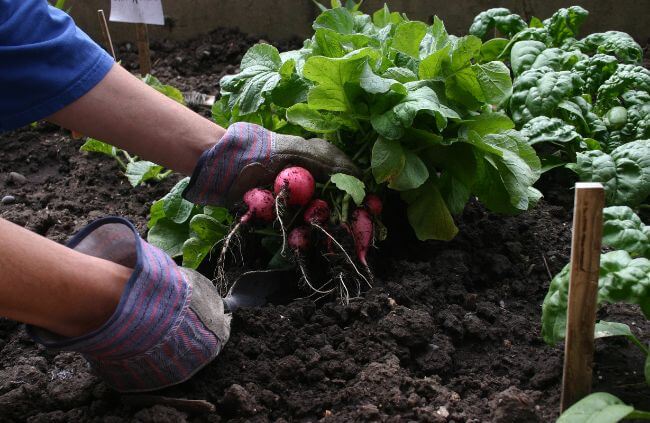
After four weeks, regardless of the time of year, check your radish roots regularly. Every variety is different, so make sure to make a note of the size of the roots before you sow them.
When the roots reach that size and get their ideal colour, pick them as soon as possible. Radishes bolt when stressed, and if they stay in the ground too long they can become woody and lose flavour.
Store radishes of all types in the fridge for the best results, as they keep in the crisper drawer for up to a month, but only a week at room temperature before they start to shrivel.
Radishes Frequently Asked Questions
What is the most popular radish to grow in Australia?
Mars and French breakfast are both incredibly popular radish varieties, but French breakfast is the most popular type of radish to grow in Australia, simply because of its ease, and visual appeal.
Do radishes need sun or shade?
Radishes need at least six hours of direct sunlight, so are usually described as full-sun lovers, but in reality, they prefer light shade in hotter parts of Australia throughout summer.
Do radishes need a lot of space to grow?
Space radishes about 5 cm apart if you can. Radishes don’t need much space to grow and can cope with being as close as 2.5 cm apart, but providing space reduces the chance of fungal infections on the leaves, and allows the soil surface to dry out between watering.
What is the best fertiliser for radishes?
We use a general-purpose tomato feed, but any reasonably balanced liquid fertiliser will help to top up soil nutrients for radishes. They like feeding but don’t need it, so anything you add is a bonus.
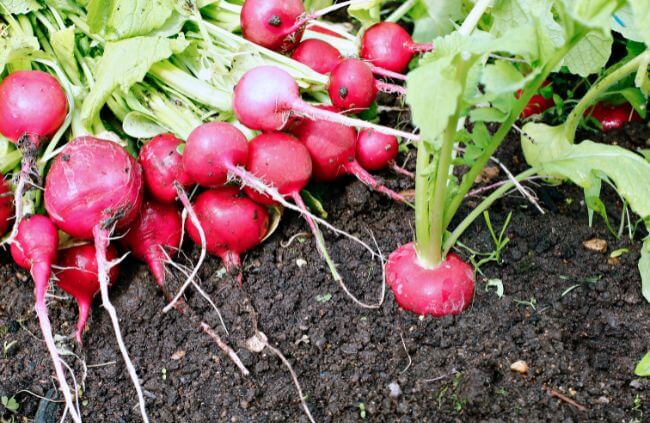
How often do radishes need to be watered?
Radishes should be watered at least once a week whether they are growing in a pot or the ground. Increase this to twice a week in summer, or whenever the soil dries out.
What happens if radishes are in the ground too long?
There are two things that can happen if radishes are in the ground too long. First, they can rot due to overwatering, or damp conditions, particularly in winter. Second, they can become woody and lose their flavour. The first visual sign of this is bolting, where they produce a flowering stem.
What is the best radish for hot climates?
‘Sora’ is one of the best radishes for hot climates, and doesn’t mind a bit of neglect, even on the hottest days. It has good bolt resistance and can be grown all year round in warmer parts of Australia. It has good bolt resistance and excellent flavour.
Pick Your Favourite from These Types of Radishes
Because radishes are such a quick crop to grow from seed to harvest, they do take a little bit of vigilance, but even if you like to embrace laid-back gardening, they will grow and produce crops with very little input.
Try to stay on top of watering and feeding, but don’t worry too much if you forget. Nine times out of ten, growing your own radishes will produce a good crop regardless of your input!
Published on August 7, 2025 by Maisie Blevins
Last Updated on January 23, 2025




